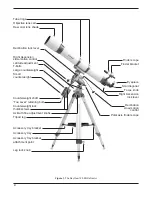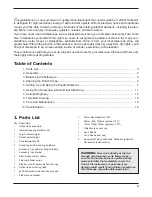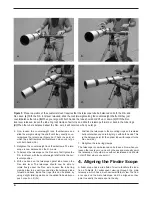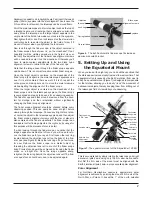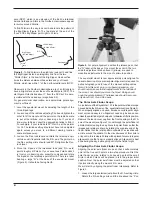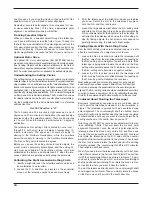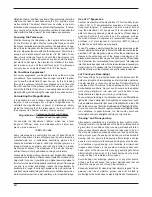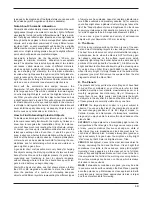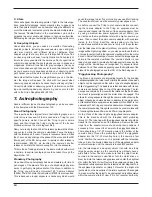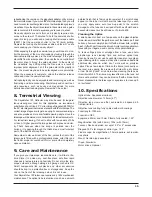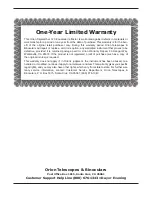
15
repositioning the camera on the piggyback adapter, or by moving
the main telescope. If you move the main telescope, then you will
need to recenter another guide star on the illuminated eyepiece’s
crosshairs. Once the object is centered in the camera and a guide
star is centered in the reticle eyepiece, you’re ready to shoot.
Deep-sky objects are quite faint, and typically require expo-
sures on the order of 10 minutes. To hold the camera’s shutter
open this long, you will need a locking shutter release cable
(#5231). Set the camera’s shutter to the “B” (bulb) setting.
Depress the locking shutter release cable and lock it. You are
now exposing your first deep-sky object.
While exposing through the camera lens, you will need to mon-
itor the accuracy of the mount’s tracking by looking through the
illuminated reticle eyepiece in the main telescope. If the guide
star drifts from its initial position, then use the hand controller of
the motor drive to “move” the guide star back to the center of
the crosshairs. Any drifting along the Dec. axis is a result of
improper polar alignment, so if the guide star drifts greatly in
Dec., the mount may need to be polar aligned more accurately.
When the exposure is complete, unlock the shutter release
cable and close the camera’s shutter.
Astrophotography can be enjoyable and rewarding, as well as
frustrating and time-consuming. Start slowly and consult out-
side resources, such as books and magazines, for more
details about astrophotography. Remember...have fun!
8. Terrestrial Viewing
The Skywatcher 120 Refractor may also be used for long-dis-
tance viewing over land. For this application we recommend
substitution of an Orion 45° Correct-Image Diagonal (#8790) for
the 90° star diagonal that comes standard with the telescope.The
correct-image diagonal will yield an upright, nonreversed image
and also provides a more comfortable viewing angle, since the
telescope will be aimed more horizontally for terrestrial subjects.
For terrestrial viewing, it’s best to stick with low powers of 50x
or less. At higher powers the image loses sharpness and clar-
ity. That’s because when the scope is pointed near the
horizon, it is peering through the thickest and most turbulent
part of the Earth’s atmosphere.
Remember to aim well clear of the Sun, unless the front of the
telescope is fitted with a professionally made solar filter and
the finder scope is covered with foil or some other completely
opaque material.
9. Care and Maintenance
If you give your telescope reasonable care, it will last a life-
time. Store it in a clean, dry, dust-free place, safe from rapid
changes in temperature and humidity. Do not store the tele-
scope outdoors, although storage in a garage or shed is OK.
Small components like eyepieces and other accessories
should be kept in a protective box or storage case. Keep the
cap on the front of the telescope when it is not in use.
Your Skywatcher 120 telescope requires very little mechanical
maintenance. The optical tube is aluminum and has a smooth
painted finish that is fairly scratch-resistant. If a scratch does
appear on the tube, it will not harm the telescope. If you wish,
you may apply some auto touch-up paint to the scratch.
Smudges on the tube can be wiped off with a soft cloth and a
household cleaner such as Windex or Formula 409.
Cleaning the Optics
A small amount of dust or a few specks on the glass objective
(main) lens will not affect the performance of the telescope. If dust
builds up, however, simply blow it off with a blower bulb, or lightly
brush it off with a soft camel hair brush. Avoid touching optical sur-
faces with your fingers, as skin oil may etch optical coatings.
To remove fingerprints or smudges from a lens, use photo-
graphic-type lens cleaning fluid and lint-free optical lens
cleaning tissue. Do not use household cleaners or eyeglass-
type cleaning cloth or wipes, as they often contain undesirable
additives like silicone, which don’t work well on precision
optics. Place a few drops of fluid on the tissue (not directly on
the lens), wipe gently, then remove the fluid with a dry tissue
or two. Do not “polish” or rub hard when cleaning the lens, as
this will scratch it. The tissue may leave fibers on the lens, but
this is not a problem; they can be blown off with a blower bulb.
Never disassemble the telescope or eyepieces to clean opti-
cal surfaces!
10. Specifications
Optical tube: Seamless aluminum
Objective lens diameter: 120mm (4.7")
Objective lens: crown and flint, achromatic, air-spaced, dif-
fraction limited
Objective lens coating: fully coated with multi-coatings
Focal length: 1000mm
Focal ratio: f/8.3
Eyepieces: 25mm and 10mm Plössls, fully coated, 1.25"
Magnification: 40x (with 25mm), 100x (with 10mm)
Focuser: Rack and pinion, accepts 1.25" or 2" accessories
Diagonal: 90° star diagonal, mirror type, 1.25"
Finder scope: 6x magnification, 30mm aperture, achromatic,
crosshairs
Mount: German-type equatorial
Tripod: Aluminum
Motor drives: Optional


